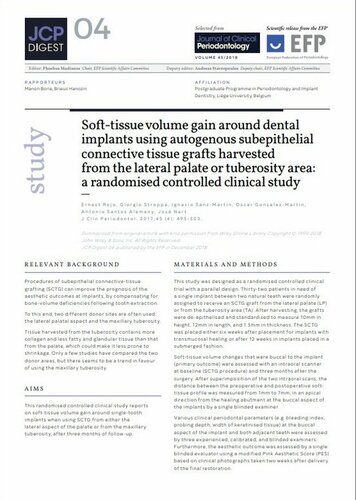![]()
14 December 2018
JCP Digest: Study compares donor sites for autogenous subepithelial connective-tissue grafting
Categories:Clinical Practice, Communication, Science

After tooth extraction, subepithelial connective-tissue grafting (SCTG) can improve the prognosis of the aesthetic outcomes at implants by compensating for bone-volume deficiencies.
Tissues are usually harvested from two donor sites: the lateral palatal aspect and the maxillary tuberosity. While there is a trend towards using the maxillary tuberosity – which contains more collagen and has less fatty and glandular tissue that that of the palate – only a few studies have compared the two donor areas.
This was the context in which researchers at International University of Catalonia in Barcelona, Spain, performed a randomised controlled clinical study to compare the two approaches.
The study – summarised as JCP Digest 04 (2018: 45) – concluded that using an SCTG from the tuberosity area yielded similar amounts of soft-tissue volume and significantly larger keratinised-tissue width compared to an SCTG from the lateral aspect of the palate.
However, as the research was completed in only three months, the researchers added that further follow-up was needed to evaluate long-term stability.
The study was published in the April 2018 edition of the EFP’s Journal of Clinical Periodontology. It was summarised for JCP Digest by third-year students at the EFP-accredited postgraduate programme in periodontology and implant dentistry at Liège University in Belgium.




